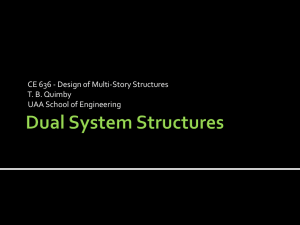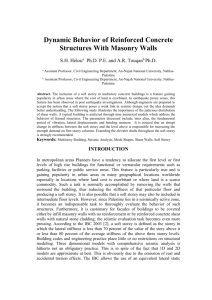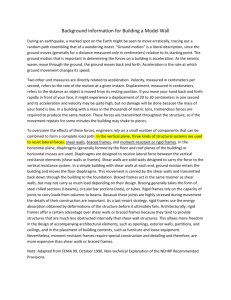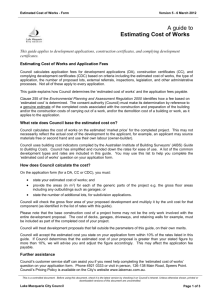scrutiny of the equivalent - An-Najah Staff - An
advertisement
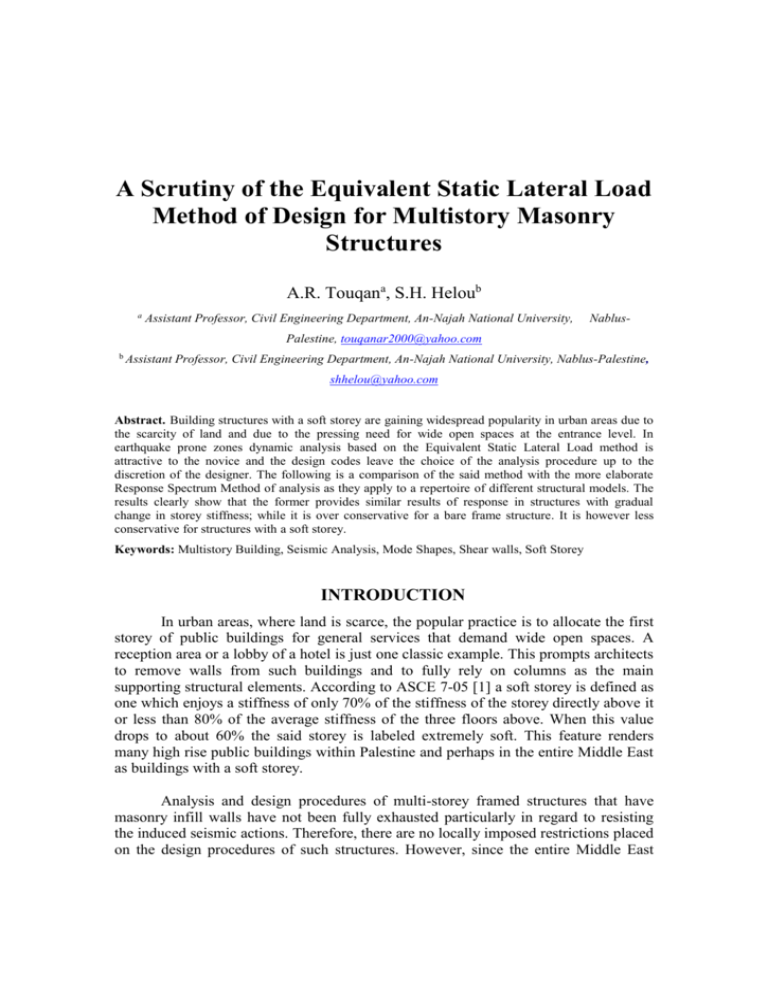
A Scrutiny of the Equivalent Static Lateral Load Method of Design for Multistory Masonry Structures A.R. Touqana, S.H. Heloub a Assistant Professor, Civil Engineering Department, An-Najah National University, Nablus- Palestine, touqanar2000@yahoo.com b Assistant Professor, Civil Engineering Department, An-Najah National University, Nablus-Palestine, shhelou@yahoo.com Abstract. Building structures with a soft storey are gaining widespread popularity in urban areas due to the scarcity of land and due to the pressing need for wide open spaces at the entrance level. In earthquake prone zones dynamic analysis based on the Equivalent Static Lateral Load method is attractive to the novice and the design codes leave the choice of the analysis procedure up to the discretion of the designer. The following is a comparison of the said method with the more elaborate Response Spectrum Method of analysis as they apply to a repertoire of different structural models. The results clearly show that the former provides similar results of response in structures with gradual change in storey stiffness; while it is over conservative for a bare frame structure. It is however less conservative for structures with a soft storey. Keywords: Multistory Building, Seismic Analysis, Mode Shapes, Shear walls, Soft Storey INTRODUCTION In urban areas, where land is scarce, the popular practice is to allocate the first storey of public buildings for general services that demand wide open spaces. A reception area or a lobby of a hotel is just one classic example. This prompts architects to remove walls from such buildings and to fully rely on columns as the main supporting structural elements. According to ASCE 7-05 [1] a soft storey is defined as one which enjoys a stiffness of only 70% of the stiffness of the storey directly above it or less than 80% of the average stiffness of the three floors above. When this value drops to about 60% the said storey is labeled extremely soft. This feature renders many high rise public buildings within Palestine and perhaps in the entire Middle East as buildings with a soft storey. Analysis and design procedures of multi-storey framed structures that have masonry infill walls have not been fully exhausted particularly in regard to resisting the induced seismic actions. Therefore, there are no locally imposed restrictions placed on the design procedures of such structures. However, since the entire Middle East region is known to lie on an active earthquake prone zone, the task of comprehensively understanding the behavior of such structures becomes an indispensable undertaking. METHODS OF ANALYSIS Several methods are available to analyze structures for earthquake loading. The time history is the source from which response spectrum curves are produced and used through either dynamic analysis (without restrictions) or equivalent lateral static analysis (with restrictions) to perform seismic analysis of structures. The restrictions to the equivalent lateral static method can be summarized as follows: 1. General assumptions: these are intended to ensure that the fundamental mode shape governs the behavior of structure. For such structures equivalent two or three dimensional static analysis may be performed. However, the method should not be used for structures with either horizontal irregularity particularly a torsion irregularity, or vertical irregularity such as the presence of a soft-storey. According to Wilson [2] regular structures are defined as the structures in which a minimum coupling exists between the lateral displacements and the torsion rotations for the mode shapes associated with the lower frequencies of the system. 2. Special assumptions: These are required for estimating the fundamental period of the structure. The assumptions are influenced by the topology of the structure as well as by its material properties and loadings [3]. The above shows that the equations recommended by design codes are valid under specific conditions. If the method is applied to structures that do not meet such conditions erroneous results become inevitable. The following presentation shows a comparison between the three dimensional Equivalent Lateral Static Load Method of analysis and the three dimensional dynamic Response Spectrum Method of analysis as they are applied to a broad range of structures with different vertical irregularities while keeping a regular floor plan arrangement. THE STRUCTURAL MODELS STUDIED For the purpose of the present undertaking a symmetrical reinforced concrete structure is randomly selected. The selected building is a typical seven storey residential one with each level having a three meter height. Each floor has two housing units with an access stairway in between. The first level of the selected building is a typical parking area servicing the occupants. The building is comprised of a reinforced concrete structural frame with infill masonry or shear walls. The foundations in all models are assumed fixed for simplicity. For the purpose of this presentation the live load is taken to be 3kN/m2, the floor finish load is taken as 1.5kN/m2. The IBC 2003 [4] response spectrum with 5% damping ratio is adopted in the study. The design spectral response acceleration at short period Sds and at one second period Sd1 are assumed to be 0.333g and 0.133g respectively. The unit weights for concrete and masonry are taken as 25kN/m3 and 20kN/m3 respectively. The elastic modulus of concrete is taken as 28,500MPa and that of masonry is taken as 3,500MPa. The Poisson's ratio for both concrete and masonry is taken as 0.2. The total height of the building is 21 meters; its length is 21 meters while the width is 12 meters. The numerical models are built using SAP2000 Version 11 [5]. The live load contribution to the seismic mass is estimated at 30% in addition to the full dead load and the self weight of the structure. The following five study models are numerically investigated; they vary in the infill walls distribution and in the respective material properties. Both the long and the short directions of the building are investigated. The study models are given the following names and descriptions: 1. BFrame: This is a bare structural frame for all levels. 2. Masonry: This is the bare frame of model 1 but with 15 cm infill un-reinforced masonry walls at all levels but at the soft storey level no walls are included. Window openings are assumed small thus they are totally neglected. 3. Shear wall (soft storey): same as in model 2 but reinforced concrete walls are included to act as shear walls. 4. Stiff column: same as in model 2 but the columns of the first storey are made substantially stiffer (60 cm x 60 cm). 5. Gradual: this is the same as in model 2 but the short direction has one shear wall in the soft storey, two shear walls in the above storey and three shear walls in the third and above levels while in the long direction the soft storey has one shear wall, the second storey has three shear walls and the third and above levels have 5 shear walls. A schematic diagram of the five study models is shown in Figure 1. Models 2, 3 and 4 Model 1 Model 5 FIGURE 1: A schematic diagram for the five study models. Model Description In constructing the various numerical models except for model 4, all columns are assumed having a square cross section of 40cmx40cm; solid slabs and walls are modeled as shell elements of 20cm thickness sitting on continuous drop beams of 40 cmx40cm sections. Beams and columns are modeled as frame elements. The frame element is a two-node (each having six degrees of freedom) element using a 3D beam column formulation which includes the effects of biaxial bending, torsion, axial deformation and biaxial shear deformations. Slabs and walls are modeled as shell elements. The shell element is a four-node formulation (each having six degrees of freedom) that combines separate membrane and plate-bending behavior. The membrane behavior uses an isoperimetric formulation that includes translational inplane stiffness components and a rotational stiffness component in the direction normal to the plane of the element. The plate bending behavior includes two-way, outof-plane, plate rotational stiffness components as well as a translational stiffness component in the direction normal to the plane of the element. Window openings, tiny relative to the overall wall area are excluded from the model as they have no appreciable bearing on the general behavior of the structure. Supports at the base are assigned a total fixation. Figure 2 shows the general floor plan of the building used in the study. A set of 12 eigenvectors are requested in the analysis. Masonry walls with no reinforcement bars are modeled as contributing to the mass of the structure but without ductility provision. FIGURE 2: Floor plan of all structural models. Results of the Analysis Comparison of the Natural Periods The fundamental period of vibration using the ASCE 7-05 equation T= 0.0466HN0.9 (H in meters) is 0.72 seconds, and for the rest of the modes T= 0.049HN3/4 is 0.48 seconds. Such values are slightly different from the values obtained from the modal decomposition analysis shown in Table 1 which shows a comparison between the first three modal periods, directions and mass participation ratios. TABLE 1: Tabular comparison of the fundamental periods for the selected model 1st mode Model No. T Direction (sec) 2nd mode Mass T Direction 3rd mode Mass T Direction Mass part. partic. partic. ratio ratio ratio 1 0.90 Uy 0.83 0.88 Ux 0.83 0.79 Rz 0.83 2 0.56 Uy 0.94 0.49 Ux 0.98 0.43 Rz 0.99 3 0.47 Uy 0.99 0.43 Ux 0.99 0.39 Rz 0.99 4 0.44 Uy 0.85 0.35 Ux 0.90 0.29 Rz 0.94 5 0.36 Uy 0.79 0.35 Rz 0.98 0.31 Ux 0.85 It is clear that the code expression for the period does not make any distinction between the values of the period with respect to the different directions. Model 1 has the largest mass to stiffness ratio hence the largest period. It provides almost equal periods in both directions with a mass participation factor of 0.83 for the first three modes. This makes it imperative that additional modes be included in the analysis in order to account for the code desired 90% cumulative mass participation. While reinforced shear walls add substantial stiffness to the structure, pure infill walls add little stiffness if any. Reinforced concrete infill walls in upper floors combined with some side reinforced concrete shear walls at the first storey provide the best alternative from a strict vibration vantage point. Comparison of lateral displacements Plots of the storey level displacement in the short and in the long directions versus height are made for all models and superposed on the same graph. Two plots are made for each direction; one using a three dimensional Response Spectrum analysis and the other using an Equivalent Lateral Static Load analysis. These are presented in Figure 3. It is readily observed that displacements in all cases are consistently lower with increasing number of models 1-5 and in both methods. The decrease in the displacement value is about one order of magnitude. Furthermore, it is clear that model 3, the shear walls model, behaves almost as a rigid body with a high relative magnitude of displacement at the first storey level. x-displacement versus height x-displacement versus height 25 20 Bframe 20 15 masonry 15 10 shear wall stiff coll 5 0 0.02 0.04 0.06 0.08 Bframe masonry shear wall 10 stiff coll 5 gradual gradual 0 -5 height height 25 0 Poly. (Bframe) -5 0 0.03 0.04 Poly. (stiff coll) Poly. (gradual) (b) 2 per. Mov. Avg. (shear wall) 2 per. Mov. Avg. (shear wall) y-displacement versus height y-displacement versus height 25 25 Bframe 20 stiff coll masonry 15 height shear wall 10 Bframe 20 masonry 15 shear wall 10 stiff coll 5 5 gradual gradual 0 0 -5 Poly. (Bframe) x-displacement Poly. (gradual) (a) 0.02 Poly. (masonry) 2 per. Mov. Avg. (masonry) Poly. (stiff coll) x-displacement height 0.01 0 0.01 0.02 0.03 y-displacement 0.04 0.05 Poly. (Bframe) -5 Poly. (masonry) 2 per. Mov. Avg. (shear wall) Poly. (stiff coll) 0 0.02 0.04 (d) y-displacement 0.06 0.08 Poly. (Bframe) Poly. (masonry) 2 per. Mov. Avg. (shear wall) Poly. (stiff coll) (c) (d) Poly. (gradual) Poly. (gradual) FIGURE 3. Displacement in the short and long directions versus height (units in meters): (a, c) using three dimensional Dynamic Response Spectrum Method; (b, d) using the Equivalent Lateral Static Load Method Comparison of Lateral Displacement Values and Design Forces Selecting models 1, 3 and 5 and plotting on the same diagram displacements and forces resulting from both the Equivalent Lateral Static Load Method and from the dynamic Response Spectrum Method versus height yields Figures 4-6. It is obvious from the graphs that the former gives similar response as the later method for gradual distribution of stiffness. However the former is over conservative in the bare frame model, and as apparent in Figures 4a and 6 it is much less conservative for structures with a soft storey. x-displacement versus height 25 frame-res height 20 frame-eq 15 shear-res 10 shear-eq 5 grad-res 0 -5 grad-eq 0 0.02 0.04 0.06 0.08 x-displacement Poly. (frame-res) Poly. (frame-eq) (a) 2 per. Mov. Avg. (shear-eq) Poly. (grad-res) y-displacement versus height 2 per. Mov. Avg. (shear-res) 25 frame-res 20 frame-eq height 15 shear-res 10 shear-eq 5 grad-res 0 -5 0 0.02 0.04 0.06 y-displacement 0.08 grad-eq Poly. (frameres) Poly. (frame-eq) 2 per. Mov. Avg. (shear-res) 2 per. Mov. Avg. in FIGURE 4. Displacement in the short and the long directions versus height (units (shear-eq) meters) Poly. (grad-res) (b) force in KN axial and shear force in corner column in xdirection 1000 900 800 700 600 500 400 300 200 100 0 axial force shear force frameres frameeq shearres shear- grad-res grad-eq eq force in KN axial force and shear force in corner column in ydirection 1800 1600 1400 1200 1000 800 600 400 200 0 axial force shear force frameres frameeq shearres shear- grad-res grad-eq eq FIGURE 5. Forces in a typical corner column in the short and long directions at first-story bending moment in corner column Moment in KN-m 500 400 300 bending moment in xdirection 200 bending moment in ydirection 100 0 frameres frameeq shearres shear- grad-res grad-eq eq FIGURE 6. Bending moment in a corner column in the short and in the long directions at first-story CONCLUSIONS In earthquake prone zones earthquake analysis is mandatory but the method of analysis is left up to the discretion of the designer. Methods of analysis presently available include the dynamic Response Spectrum Method and the Equivalent Lateral Static Load Method. In the construction industry the later method is preferred over the former. The choice is based on a number of factors such as its apparent mathematical simplicity and its shorter running time. However, when both methods are applied to a range of structural models that have a regular floor plan but vertical irregularities it becomes apparent that the two mentioned methods give different results. The Equivalent Lateral Static Load provides similar results of response for gradual distribution of stiffness; it is however over conservative for the bare frame case and much less conservative for soft storey structures. REFERENCES 1. 2. 3. 4. 5. ASCE, "Minimum Design Loads for Buildings and Other Structures", ASCE/SEI 7-05, 2006, pp109-132. Wilson Edward L., "Three Dimensional Static and Dynamic Analysis of Structures", Computers and structures, Inc., Berkeley, California, 2001, chapter 17. Touqan Abdul Razzaq, "Necessity of Upgrading Methods of Analysis for Seismic Resistant Design", The International Earthquake Engineering Conference", 2005, paper 17. 2003 International Building Code, International Code Council. Habibullah, A. et al, (2007) SAP 2000 "Static and Dynamic Finite Element Analysis of Structures", Computers and Structures Inc. Berkeley, California.

